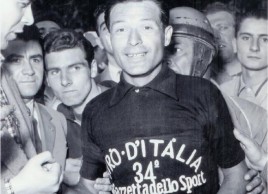What does each jersey mean in the Giro?
The different jerseys that identify each of the leaders in the various general classifications have a reason that the organization of the Italian race explains to us. Precious garments, like in any of the three Grand Tours, are highly valued and fiercely fought over during the three weeks of the Giro d'Italia.

The colors of the Giro d'Italia jerseys were not chosen at random
Except in the Vuelta a España, where the identifying color of the race leader has been changing, in the three Grand Tours the leader's jerseys have a long history behind them that have turned the different garments that identify the leader of each classification, especially the general classification, into clear icons that fans associate with each race.
In the case of the Giro d'Italia, undoubtedly the color we associate with this race is the Maglia Rosa of the general classification leader. In fact, among the nicknames by which this race is known, one of them is the Corsa Rosa. A jersey that was introduced to the race in 1931 and, like the Tour de France, owes its color to the pages of the newspaper La Gazzetta dello Sport, whose paper still has this characteristic color and which organized the race from its origins in 1909.
RECOMENDADO

25 cycling gifts ideas to get it right

When do helmets have to be changed? Do they have an expiration date?

Some reasons to stay away from the road in winter

S-Works: what does it really mean and where does Specialized's most exclusive label come from?

The best apps for cycling and mountain biking

Black Friday 2025 cycling bargains: save on Garmin, POC, Maxxis and more

As a curiosity, the introduction of the pink jersey coincided with the rise of fascism in the figure of Benito Mussolini, who already detested cycling considering it a "red sport," and for him the garment that identified the race leader was the height of it, expressing that he considered this color feminine and that it reminded him of women's underwear.
The Maglia Azurra, which serves to identify the leader of the mountain classification, is another of the most valued jerseys of the Giro d'Italia. According to the Giro d'Italia, its color is due to the color of the sky, symbolizing the heights to which the climbers of the peloton ascend to win it. However, for Italians, it also has an extra meaning that makes it particularly dear to them. After all, blue is the color that identifies their national teams.

Also iconic of the Giro d'Italia is the Maglia Ciclamino, a color that we do not see in any other race on the calendar and that serves to recognize the leader of the points classification. In this case, its color is due to the Cyclamen, a plant that blooms between autumn and winter and whose flowers are of this intense purple-like color. In this case, it symbolizes the perseverance of the fast men who, during the three weeks of the race, must be at the front in every intermediate sprint and at every finish to collect enough points to win this classification.
Finally, there is the Maglia Bianca, a color shared by the three Grand Tours as the identifier of the best cyclist in the young rider classification. The white jersey symbolizes the page that is yet to be written, as a reference to the promising career of the cyclists who manage to conquer this garment, although, truth be told, in recent years it has lost some of its essence in many races on the calendar since the best cyclists in the world are also some of the youngest, so, on many occasions, the winner of this classification coincides with the general classification winner.

Currently, these are the identifying jerseys, but many remember a very special one that was in use between 1946 and 1951. This is the Maglia Nera, which, during those years, served to identify the last cyclist in the general classification. However, there came a time when it got out of hand, with cyclists intentionally losing time to occupy this position since, after all, wearing an identifying jersey always gives some media relevance, so this garment ended up disappearing from the race and today it remains iconic and missed by many.